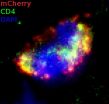(Press-News.org) SAN FRANCISCO -- The information that interprets the genetic code in a new embryo differs depending on whether it comes from the father or mother, researchers at San Francisco State University have found.
The research, detailed in an article published today in the journal PLOS Genetics, sheds light on the multilayered process of how a sperm and egg pass along information needed for successful reproduction. Though one layer is the DNA code that is transferred, the new study identifies information not encoded by DNA, a so-called "epigenetic" layer of information that helps the cell interpret the genetic code.
Scientists have known these "epigenetic marks," which influence the developmental plan of new embryos, are created by biologically modifying the proteins, called histones, that are responsible for tightly coiling DNA inside cells. But the new study shows how distinctive the marks from a sperm cell are from the information coming from an oocyte, or egg cell.
"We were able to document an array of marks from dad that are different than what is passed over from mom," said Diana Chu, an associate professor of biology at SF State. "This research opens up new avenues for scientists to investigate. What is the role of these different marks? Why are they different?"
Chu and her colleagues at SF State and the Scripps Research Institute examined sperm and embryos of the C. elegans worm to identify which histone marks, which include histone variants and modifications, were unique to sperm and track them during the formation of new sperm cells and new embryos. They found that the number of histone modifications present within sperm is 2.4 times less than the number present within embryos, indicating a widespread erasure of epigenetic marks when new sperm cells are formed. But the erasure is incomplete: Researchers identified one histone variant and six histone modifications -- and there are likely many more -- that are retained in sperm and ultimately passed on to a new embryo, potentially helping it develop properly.
"If the DNA is the book, these variants and modifications are the bookmarks," Chu said. "They can help cells read the book."
The discovery adds another dimension for scientists to explore when studying the complex process of how genetic information is passed on from parents to children. Such research has major health implications, Chu added, as developmental and behavioral disorders that may not manifest themselves until years or even decades into an individual's life can originate in the early stages of embryotic development.
"These various levels of genetic and epigenetic information work in combination," she said. "If you don't understand all of them, you can't understand the complexity how cells divide properly and how they create a human being who can function at many different levels for a long period of time."
Further research will identify additional epigenetic marks that are unique to sperm, as well as study more closely the role and features of a specific histone variant, termed HTAS-1.
"The specification and global reprogramming of histone epigenetic marks during gamete formation and early embryo development in C. elegans" by Mark Samson, Margaret M. Jow, Catherine C.L. Wong, Colin Fitzpatrick, Aaron Aslanian, Israel Saucedo, Rodrigo Estrada, Takashi Ito, Robin Park, John R. Yates III and Diana S. Chu was published in the Oct. 9 edition of PLOS Genetics. The research was funded through several grants from the National Science Foundation.
INFORMATION:
SF State is the only master's-level public university serving the counties of San Francisco, San Mateo and Marin. The University enrolls nearly 30,000 students each year and offers nationally acclaimed programs in a range of fields -- from creative writing, cinema, biology and history to broadcast and electronic communication arts, theatre arts and ethnic studies. The University's more than 228,000 graduates have contributed to the economic, cultural and civic fabric of San Francisco and beyond.
Most women are infected with HIV through vaginal intercourse, and without effective vaccines or microbicides, women who cannot negotiate condom use by their partners remain vulnerable. How exactly the virus establishes infection in the female reproductive tract (FRT) remains poorly understood. A study published on October 9th in PLOS Pathogens reports surprising results from a study of HIV transmission in the FRT of rhesus macaques.
Most studies of HIV transmission after vaginal exposure to date have been done in rhesus macaques and focused on the cervix, the lower part ...
VIDEO:
This video explains research done to understand the motion used by sidewinder snakes to climb sandy slopes and to apply that motion to a snake-like robot. Researchers from Georgia Tech,...
Click here for more information.
The amazing ability of sidewinder snakes to quickly climb sandy slopes was once something biologists only vaguely understood and roboticists only dreamed of replicating. By studying the snakes in a unique bed of inclined sand and using a snake-like robot ...
CANCER RESEARCH UK scientists have discovered that lung cancers can lie dormant for over 20 years before suddenly turning into an aggressive form of the disease, according to a study published in Science* today (Thursday).
The team studied lung cancers from seven patients – including smokers, ex-smokers and never smokers. They found that after the first genetic mistakes that cause the cancer, it can exist undetected for many years until new, additional, faults trigger rapid growth of the disease.
During this expansion there is a surge of different genetic faults ...
When young mice with the rodent equivalent of a rare autism spectrum disorder (ASD), called Rett syndrome, were fed a diet supplemented with the synthetic oil triheptanoin, they lived longer than mice on regular diets. Importantly, their physical and behavioral symptoms were also less severe after being on the diet, according to results of new research from The Johns Hopkins University.
Researchers involved in the study think that triheptanoin improved the functioning of mitochondria, energy factories common to all cells. Since mitochondrial defects are seen in other ...
During their approximately 100-day lifespan in the bloodstream, red blood cells lose membrane surface area, volume, and hemoglobin content. A study publishing this week in PLOS Computational Biology finds that of these three changes, only the observed surface-area loss can be explained by RBCs shedding small hemoglobin-containing vesicles budding off their cells' membrane.
Red blood cell concentration, mean volume, and hemoglobin content are routinely measured in the complete blood count, a fundamental clinical test essential to the screening, diagnosis, and management ...
As birth rates decline in countries that include parts of Europe and East Asia, threatening the economic slowdown associated with aging populations, a global study from the University of California, Berkeley, and the East-West Center in Hawaii suggests that in much of the world, it actually pays to have fewer children. The results challenge previous assumptions about population growth.
Researchers in 40 countries correlated birth rates with economic data and concluded that a moderately low birth rate – a little below two children per woman – can actually ...
A team of scientists including a University of Colorado Boulder professor used NASA's Hubble Space Telescope to make the most detailed global map yet of the glow from a giant, oddball planet orbiting another star, an object twice as massive as Jupiter and hot enough to melt steel.
The Hubble observations show that the planet, called WASP-43b, is no place to call home. It's a world of extremes, where winds howl at the speed of sound from a 3,000-degree-Fahrenheit dayside to a pitch-black nightside when temperatures plunge to a relatively cool 1,000 degrees Fahrenheit, ...
Using X-rays and neutron beams, a team of researchers from the University of California, San Diego School of Medicine, University of Utah and Oak Ridge National Laboratory have teased out new information about Protein Kinase A (PKA), a ubiquitous master switch that helps regulate fundamental cellular functions like energy consumption and interactions with hormones, neurotransmitters and drugs.
"Mutations in PKA can lead to a variety of different human diseases, including cancers, metabolic and cardiovascular diseases and diseases involving the brain and nervous system," ...
Known cancer-driving genomic aberrations in localized lung cancer appear to be so consistently present across tumors that a single biopsy of one region of the tumor is likely to identify most of them, according to a paper published today in Science.
The study led by scientists at The University of Texas MD Anderson Cancer Center addresses the challenge of what scientists call genomic heterogeneity, the presence of many different variations that drive tumor formation, growth and progression, and likely complicate the choice and potential efficacy of therapy.
A landmark ...
A team of scientists using the NASA/ESA Hubble Space Telescope have made the most detailed map ever of the temperature of an exoplanet's atmosphere, and traced the amount of water it contains. The planet targeted for both of the investigations was the hot-Jupiter exoplanet WASP-43b.
WASP-43b WASP-43b is a planet the size of Jupiter but with double the mass and an orbit much closer to its parent star than any planet in the Solar System. It has one of the shortest years ever measured for an exoplanet of its size -- lasting just 19 hours.
A team of astronomers working ...



